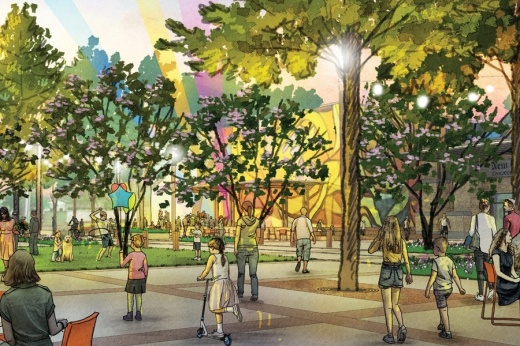The 2023 Bond Advisory Committee reviewed designs and cost estimates of $340 million worth of capital improvement projects identified by the city of New Braunfels. On Oct. 17, the committee produced an official recommendation to the New Braunfels City Council for 20 projects totaling $183 million to receive bond funding. Next, the New Braunfels City Council will review and finalize the list, reducing the funded projects to $140 million, which is the estimated capacity without a tax rate impact for a proposed May 2023 bond election.
Funding to begin the first phase of the Castell Avenue Corridor Redesign Project has been prioritized by the 2023 Bond Advisory Committee by proposing $5.9 million in bond funds be used. The first phase would move overhead utilities underground and make extensive improvements to the drainage system from San Antonio Street to Butcher Street on South Castell Avenue.
The Castell Avenue Corridor Redesign Project is a long-term project that was first discussed in the city’s 2010 Downtown Implementation Plan and was cultivated from feedback received through public meetings, committees, stakeholder groups and professional input, according to the city.
The first two elements of the project officials have moved forward on are the acquisition of the Union Pacific Railroad property on South Castell Avenue and the overall preliminary design of the functional features of the street.
“The goal of the redesign project was to turn Castell into a thriving and complete street,” said Jeff Jewell, director of economic and community development. “We wanted to incorporate design elements and features that enhance the safety, the pedestrian comfort and elevate the experience of walking in downtown New Braunfels.”
Negotiations with Union Pacific to relocate their downtown operations to elsewhere in Comal County began in 2020. The New Braunfels City Council approved an expenditure of $2.18 million from the New Braunfels Economic Development Corp. to acquire the property behind the civic center in April. There are still several steps that need to be taken to secure relocation by the fourth quarter of 2024.
“We were trying to advance this one small piece that we can, just trying to, like, pick which piece of the puzzle can we kind of move downfield. And it was the Castell design, because it’s got constraints and challenges that exist independent and outside of the property itself,” Jewell said.
Dedicated to design
The NBEDC approved funding for the preliminary design of the streetscape project in August 2021, budgeting up to $442,000.
The project on Castell Avenue stretches from West Bridge Street to I-35 and is separated into the three sections: the Downtown Core, Civic Plaza and Neighborhood Mixed. The Downtown Core portion of the project, stretching from West Bridge Street to West Coll Street, is anticipated to cost over $12 million, and encompasses drainage and overhead utilities.
Pastor Ray Still, chair of the bond advisory committee, said the decision to propose funding for the Castell Avenue project was made due to the drainage issue on the street that effects downtown businesses.
“We can’t afford as a community to make the mistake that I think we did in the past where we didn’t have any bond elections, and we didn’t make some improvements,” Still said. “And then we really had to catch up, and so I hope that the city will see the need to continue to keep addressing the issues of our community.”
The street design plan uses new sidewalks, right-of-way construction and greenery to make the corridor a more walkable space. As a result of community input, the design will incorporate materials, such as pavers and different kinds of concrete, to align with similar design aspects of the downtown area.
The Civic Plaza section of the project, from West Coll Street to Jahn Street, is anticipated to cost over $14 million with plans to develop an outdoor event space adjacent to the Civic Center. The preliminary design plans include bollards—columns that can be raised from the ground—to close off the roadway for events. A food truck zone and an area for a stage or screen have also been proposed. Additionally a one-lane roundabout is planned for the Jahn Street and Castell Avenue intersection.
The last section of the project—dubbed Neighborhood Mixed—is projected to cost over $11 million and includes the area from Jahn Street to the South I-35 frontage road. Improvements planned in the redesign for the predominantly residential portion of the project include creating uninterrupted sidewalks for pedestrians, and adding landscaping and parking zones. The street is not compliant with the American with Disabilities Act.
Long-term vision
The city anticipates the project will act as a catalyst for downtown development and has the potential for over $100 million in investments.
In the long-term preliminary plan developed by the city, the vision is to expand the Civic Center and incorporate a hotel space. Additional parking facilities would be built in the area to allow for additional downtown parking, and residential and retail buildings may be built on the property used by Union Pacific.
Jonathan Packer, President & CEO of the Greater New Braunfels Chamber of Commerce, said the project does not have a definitive timeline, but once completed, it will ultimately provide more opportunities for businesses downtown to be successful and encourage economic development that provides new amenities and improves quality of life for residents.
“From a chamber perspective, it’s a high-priority project. And the quicker we can move on major milestones, the better,” Packer said.
On Oct. 18, during the GNBCC 2022 State of the City address, New Braunfels City Manager Robert Camareno highlighted the growth taking place in New Braunfels. If growth rates continue, by 2034 nearly 87% of developable land will be used in the incorporated areas of the city.
“I think that must change the way we start to plan for the future,” Camareno said during the state of the city presentation. “Start to rethink how we position ourselves for some of that growth that still needs to occur and the redevelopment in some areas that will also occur.”
Packer said it is imperative to invest in the core of downtown to have the ability to guide the significant growth anticipated to continue in the region.
“Projections are that the city will have little to no developable land by 2035 [if] current rates of development continue,” Packer said. “So that’s why projects like the South Castell project are so important.”







